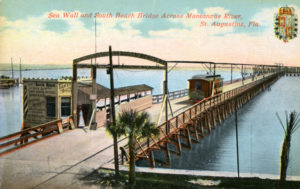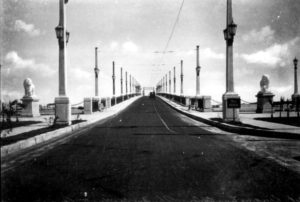This fifth installment in our ongoing series on the history of the St. Augustine Lighthouse focuses on the growth of the St. Augustine community during the early 20th century and the effect it had on the lighthouse and the people living and working there.
Click the links below to read previous posts in the series:
- Lighthouse History Pre-1874
- Lighthouse History 1874-1894 (Part I)
- Lighthouse History 1874-1894 (Part II)
- Lighthouse History 1894-1914
1914-1934
For much of their history, the lighthouses in St. Augustine stood apart from the city proper, isolated as they were by their location on Anastasia Island. The early 20th century saw the creation of roads, railroads, and bridges linking the Ancient City with its barrier island while the crowds visiting St. Augustine Beach and the lighthouse only grew.
Connecting the City and Island

Courtesy of State Archives of Florida, Florida Memory; if you look closely, you can see an advertisement for the lighthouse on the small building to the left
St. Johns Electric Company began streetcar service over a wooden bridge to the lighthouse, the Alligator Farm, and the beach. The streetcar schedules included trips to the lighthouse in the evenings, presumably so visitors could view the lighthouse at night, something guests to the Ancient City still do. A 1904 renovation introduced automobile traffic to the bridge as well.
During this time of increased traffic and development on Anastasia Island, the Lighthouse Service dispatched a surveyor to review the light station boundaries. Following his 1914 survey, he placed markers along the light station indicating the edges of the property. A few of the markers remain visible today.
As St. Augustine expanded, bringing more visitors and residents to the spiral stairs of the lighthouse, global events were conspiring to reinforce the integral role of lighthouses to maritime traffic. War raged across Europe and by 1917, it became increasingly obvious that the United States could not afford to remain uninvolved. The Lighthouse Service began restricting access to lighthouses across the country and on February 6, 1917 Head Keeper Peter Rasmusson received orders to close the tower to all guests.
The tower remained closed until the cessation of hostilities in 1918 and Peter Rasmusson worked the final few years of his tenure at the lighthouse at a time of rapid growth and change for the community. He retired in 1924 after 41 years of government service and 23 years at the St. Augustine Lighthouse. His replacement, John Lundquist, was a Swedish sailor who had served previously in St. Augustine as the 1st Assistant Keeper from 1893 to 1901 when he earned a promotion to Head Keeper at Volusia Bar Lighthouse.
Life After the War
The post-war period ushered in a renewed progress and growth in St. Augustine and on

The Bridge of Lions in the late 1920s, note the cables and rails for streetcars;
Courtesy of State Archives of Florida, Florida Memory
Anastasia Island, bringing more people to the island and improving the quality of life of the keepers and their families. The increasing volume of automobile traffic necessitated a new, modern bridge capable of handling the rapidly developing mode of transportation. On February 26, 1926 the steel-and-concrete Bridge of Lions, which the St. Augustine Record called “Dixie’s handsomest highway bridge,” opened for cars. As historian Thomas Graham noted, the bridge became, and continues to serve as, something of an attraction itself, rather than simply a way to get your car onto Anastasia Island.
The increased traffic facilitated by the Bridge of Lions, and the development of the Davis Shores community on the island continued the push of people and progress at the lighthouse. Modern technologies became more widely available. On July 23, 1925, electric lights were installed and lit in the Keepers’ House. Despite the advantages and increasing availability of electric lighting, it would be over 10 years before electricity replaced the oil lantern at the top of the tower.
By the time John Lundquist returned to St. Augustine as Head Keeper, he was coming to the end of a 38-year career in government service. He stayed in the position until January 1, 1927, at which time he retired and handed over responsibility of the light station to Clarence Malloy. Malloy served until 1935, he being the last light keeper to spend his entire career carrying fuel to the top of our oil-burning lighthouse. The introduction of electricity in the lighthouse lantern would signal a paradigm shift in the responsibilities of lighthouse keepers and slowly render those duties obsolete and redundant.
READ THE NEXT INSTALLMENT IN OUR LIGHTHOUSE HISTORY →
Visit the St. Augustine Lighthouse & Museum and take a Dark of the Moon Tour to see the now-electric lighthouse up close at night!
Paul Zielinski is Director of Interpretation for the St. Augustine Lighthouse & Museum. He received his master’s degree in Public History from the University of West Florida and joined the lighthouse family in 2011.


